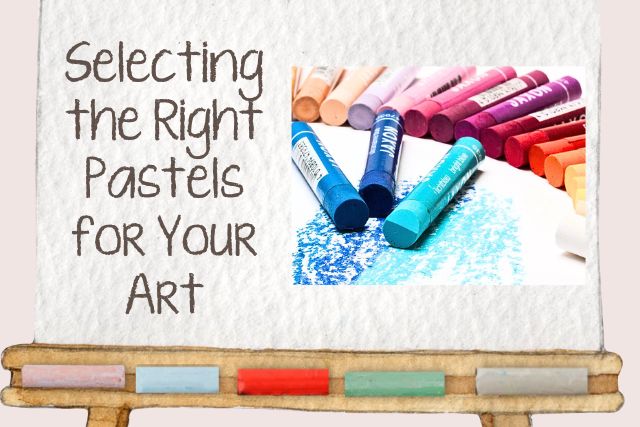Choosing the right pastels can turn a blank canvas into a vibrant masterpiece.
When painting with pastels, the journey begins long before the first stroke touches the paper. Selecting the right pastels is a crucial step that can significantly influence your artistic expression and overall experience. With a plethora of options available, understanding what to look for in pastels can help you make an informed decision and elevate your artwork to new heights.
Types of Pastels: Exploring the Spectrum
As discussed in a previous article, Different Types of Pastels, we see that they come in various types, each with unique characteristics suited to different styles and techniques. The primary categories include soft pastels, hard pastels, oil pastels, and pastel pencils.
Soft Pastels: Known for their vibrant colours and buttery texture, soft pastels are a favourite among artists because they blend effortlessly. Their broad range of colours and textures makes them ideal for creating rich, expressive artworks.
Hard Pastels: These pastels are firmer and less crumbly than their soft counterparts. They offer more precision, making them suitable for detailed work and fine lines. Hard pastels are also excellent for initial sketches and underdrawings.
Oil Pastels: With a creamy consistency, oil pastels produce intense colours but are less prone to smudging. They can be layered and blended similarly to oil paints. Oil pastels are perfect for artists who enjoy working with bold, textured effects.
Pastel Pencils: Combining the qualities of pastels and pencils, pastel pencils provide excellent control and precision. They are particularly useful for fine details and intricate work, offering a cleaner alternative to soft pastels.
Quality Matters: Student vs. Artist Grade
When choosing pastels, you’ll encounter student-grade and artist-grade options. Student-grade pastels are more affordable and suitable for beginners or those experimenting with pastels. However, they often contain more fillers and less pigment, resulting in less vibrant colours and a grainier texture.
On the other hand, artist-grade pastels boast a higher pigment concentration and superior quality. They deliver more vivid colours and a smoother application, allowing greater versatility and creative freedom. While they come at a higher price, the investment is worthwhile for serious artists seeking the best possible results.
Colour Selection: A Palette of Possibilities
The beauty of pastels lies in their extensive colour range. When building your pastel collection, consider purchasing sets that offer a variety of hues and shades. A well-rounded set should include a mix of primary and secondary colours, neutrals, and earth tones. This diversity allows you to blend and layer colours to achieve the desired effect.
For those new to pastels, starting with a smaller set and gradually expanding your collection can be a practical approach. As you become more familiar with the medium and your personal preferences, you can invest in additional colours and speciality pastels.
Surface Matters: Choosing the Right Paper
The surface you work on is just as important as the pastels themselves. Pastel paper comes in different textures and weights, influencing how the pastels adhere and blend. Look for paper designed explicitly for pastels, typically with a toothy texture to grip the pigment.
Sandpaper and velour paper are also popular choices among pastel artists. Sandpaper offers a gritty surface that holds multiple layers of pastel, while velour paper provides a soft, velvety finish. Experimenting with different surfaces can help you discover which one best complements your style and techniques.
Tools and Accessories: Enhancing Your Pastel Experience
In addition to pastels and paper, several tools and accessories can enhance your pastel painting experience. Blending tools such as tortillons, blending stumps, and soft brushes can help you achieve smooth transitions and delicate details. A fixative spray is an option for preserving your artwork and preventing smudging.
Investing in a sturdy easel can also improve your comfort and posture while working, allowing you to focus on your creativity. Lastly, proper storage solutions, such as pastel boxes or trays, can keep your pastels organized and protected.
Vegan-Friendly Options: Ethical Choices for Artists
If you are a vegan artist, you will be mindful of the materials you use. Fortunately, many pastel brands offer vegan-friendly options that do not contain animal-derived ingredients. Look for brands that explicitly state their commitment to cruelty-free and vegan products.
Conclusion: Unleash Your Creativity
Purchasing pastels for painting is an exciting step in your artistic journey. By understanding the different types of pastels, prioritizing quality, and selecting the right colours and surfaces, you can set yourself up for success. Try looking for ethical options and invest in tools that enhance your experience. With the right pastels, you can unleash your creativity and create vibrant, expressive artworks that reflect your unique vision.
If you’re wanting step by step lessons head over to the Shop and view my books.
I’d appreciate you sharing this article:




0 Comments